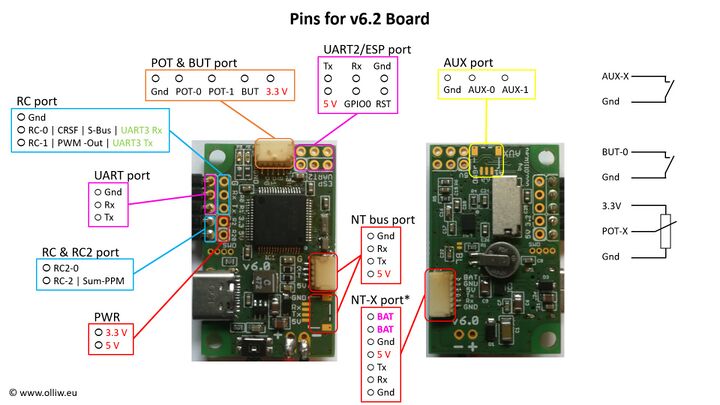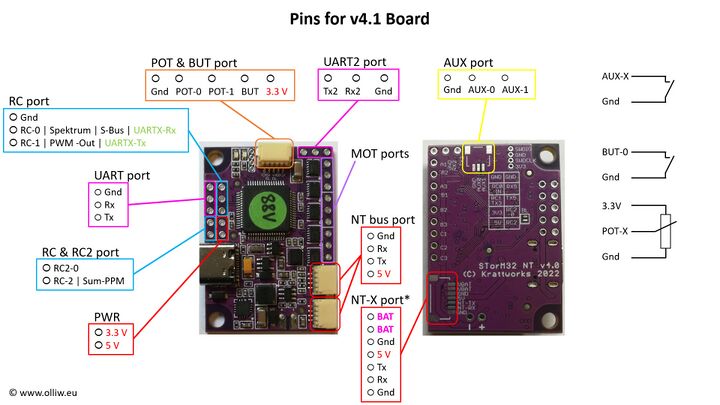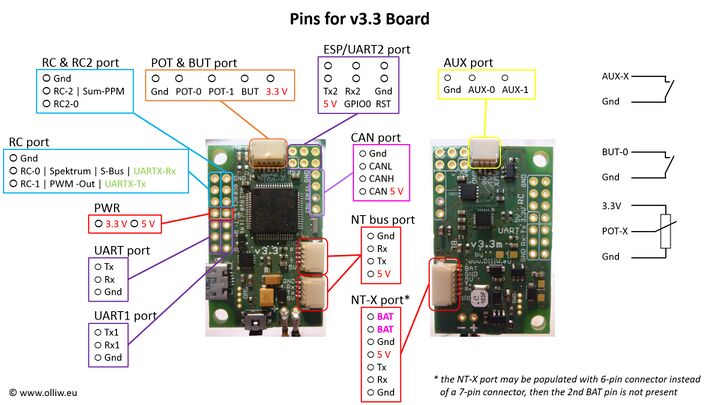STorM32 Boards: Difference between revisions
Tag: Reverted |
|||
| (6 intermediate revisions by the same user not shown) | |||
| Line 27: | Line 27: | ||
* CRSF, Futaba S-Bus | * CRSF, Futaba S-Bus | ||
* up to four PWM/Sum-PPM inputs/outputs | * up to four PWM/Sum-PPM inputs/outputs | ||
* joystick port ( | * joystick port (analog) for two axes | ||
* 2 auxiliary ports (digital), BUT port | * 2 auxiliary ports (digital), BUT port | ||
| | | | ||
| Line 53: | Line 53: | ||
* CRSF, Futaba S-Bus | * CRSF, Futaba S-Bus | ||
* up to four PWM/Sum-PPM inputs/outputs | * up to four PWM/Sum-PPM inputs/outputs | ||
* joystick port ( | * joystick port (analog) for two axes | ||
* 2 auxiliary ports (digital), BUT port | * 2 auxiliary ports (digital), BUT port | ||
| | | | ||
* supply voltage: <br/> with motor drivers enabled: 6 - 12 V or 2 - 3S <br/> with motor drivers disabled: 6 - 20 V or 2 - 4S <br/> '''''Comment''': The motor drivers are enabled by closing the JP1 solder bridge.'' | * supply voltage: <br/> with motor drivers enabled: 6 - 12 V or 2 - 3S <br/> with motor drivers disabled: 6 - 20 V or 2 - 4S <br/> '''''Comment''': The motor drivers are enabled by closing the JP1 solder bridge on the bottom side of the board.'' | ||
* motor current: 1.0 A (??) | * motor current: 1.0 A (??) | ||
* board dimensions: 40 mm x 28 mm, 35 mm bolt to bolt, holes Ø3 mm | * board dimensions: 40 mm x 28 mm, 35 mm bolt to bolt, holes Ø3 mm | ||
| Line 64: | Line 64: | ||
:[[File:Storm32-bgc-nt-v41-ports-and-connections.jpg|720px]] | :[[File:Storm32-bgc-nt-v41-ports-and-connections.jpg|720px]] | ||
{{COMMENT|The board shown in the picture is a pre-release version (doesn't show the JP1 solder bridge on the bottom side).}} | |||
=== STorM32-BGC v3.3m, v3.3i === | === STorM32-BGC v3.3m, v3.3i === | ||
| Line 75: | Line 77: | ||
* on-board IMU: ICM42605/ICM42688P/ICM42688V (v3.3i), or MPU9250 (v3.3m) | * on-board IMU: ICM42605/ICM42688P/ICM42688V (v3.3i), or MPU9250 (v3.3m) | ||
* 2x NT port and 1x NT-X port | * 2x NT port and 1x NT-X port | ||
* USB | * Micro USB connector, wired to on-board CP2102 USB-TTL adapter | ||
* UART2/ESP port | * UART2/ESP port | ||
* CRSF, Futaba S-Bus | * CRSF, Futaba S-Bus | ||
* up to four PWM/Sum-PPM inputs/outputs | * up to four PWM/Sum-PPM inputs/outputs | ||
* joystick port ( | * joystick port (analog) for two axes | ||
* 2 auxiliary ports (digital), BUT port | * 2 auxiliary ports (digital), BUT port | ||
| | | | ||
| Line 92: | Line 94: | ||
{{COMMENT|The {{BOX|CAN}} port is obsolete, and not supported anymore.}} | {{COMMENT|The {{BOX|CAN}} port is obsolete, and not supported anymore.}} | ||
:[[File:Storm32-bgc-nt-v33-ports-and-connections.jpg|720px]] | |||
Latest revision as of 05:09, 15 October 2025
"Original" STorM32 Boards
At present, board versions v3.3, v4.1 and v6.2 are supported (v0.17/v1.0, v1.1, v1.2, v1.3x, v2.4 boards are deprecated).
The STorM32 boards offer two types of NT bus ports, the NT and NT-X ports. They both are different from the NT bus connectors on the NT modules in that they have swapped Rx, Tx pins.
Comment: The Rx, Tx pins of the NT and NT-X ports on the STorM32 board must be connected to the Tx, Rx pins on the NT modules.
Comment: The v3.3 and v6.2 STorM32 boards have no motor drivers on-board, i.e., NT motor modules are needed in addition.
In addition to the boards shown here, also other variants exist, such as e.g. micro versions.
The design schemes are located in https://github.com/olliw42/storm32bgc
STorM32-BGC v6.2
|
|
Comment: This board has no motor drivers; NT motor modules are thus mandatorily required.
STorM32-BGC v4.1
|
|
Comment: This board is design of KrattWorks, [1].
Comment: The board shown in the picture is a pre-release version (doesn't show the JP1 solder bridge on the bottom side).
STorM32-BGC v3.3m, v3.3i
|
|
Comment: Tthe v3.3i version has a ICM42605/ICM42688P/ICM42688V on-board IMU, the v3.3m version has a MPU9250 on-board IMU.
Comment: This board has no motor drivers; NT motor modules are thus mandatorily required.
Comment: The CAN port is obsolete, and not supported anymore.


